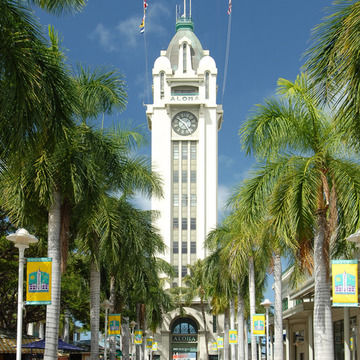The major landmark of Honolulu's harbor area, Aloha Tower served as a symbol of welcome for travelers arriving in the territory in the years when ships, rather than planes, were the primary means of accessing the Islands. Built to house offices and provide a vantage point for harbor control, the ten-story, 184-foot-high, reinforced-concrete tower presents a modern face with its convexly rounded pyramidal dome and similar corner pylons. Until 1945 it was the tallest structure in Hawaii.
The tower was completed in 1926, but only after considerable debate. In 1920, money was appropriated to rebuild Piers 8, 9, and 10 with concrete sheds and to construct Aloha Tower. However, the Board of Harbor Commissioners postponed their decision on the precise character of the tower until the piers were completed. By 1924, when the piers were nearing completion, the original bulky tower proposal had been supplanted by the more graceful design developed by Arthur Reynolds. At this time the tower became a source of public controversy. A number of citizens, led by the powerful Cooke family, voiced strong opposition to the tower, fearing it would detract from the natural beauty of the Islands by marring ship passengers' views of the mountains. After considerable public debate, the Board of Harbor Commissioners decided to proceed with the construction of the tower in October 1924, only to revisit the issue a year later when supporters of the tower urged that the height be increased to 208 feet by the addition of three more stories. This proposal proved unsuccessful, but delayed the completion of the tower until 1926.
Arthur Reynolds (1863–1925) had a longstanding relationship with Hawaii. Born in England, he came to the Islands in fall 1891 from Chicago by way of San Francisco. He immediately entered into partnership with Clinton Briggs Ripley, which lasted until 1895 when Reynolds departed on a trip around the world. He resumed his partnership with Ripley in Oakland in 1907, and the pair returned to Hawaii in 1910, designing buildings in a variety of historic styles, including the Spanish Mission Revival Central YMCA (1912; demolished) and Hawaii Hall at the University of Hawaii (OA122.1). In 1912 Reynolds again left the Islands, only to return in 1919. The Aloha Tower is his best-known building. He did not see it completed, having died of a stroke in August 1925.


